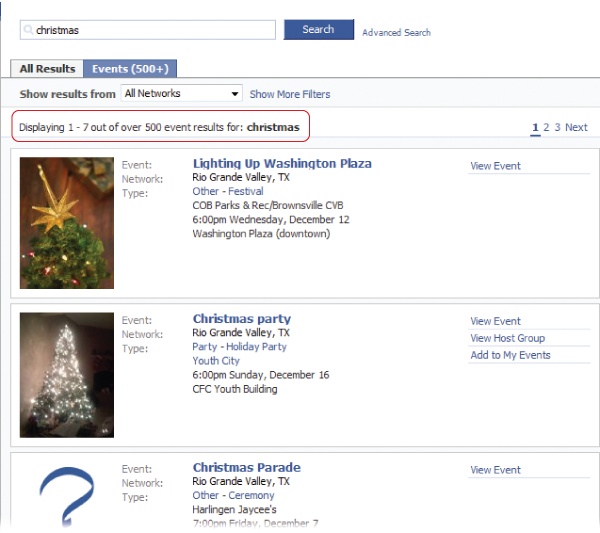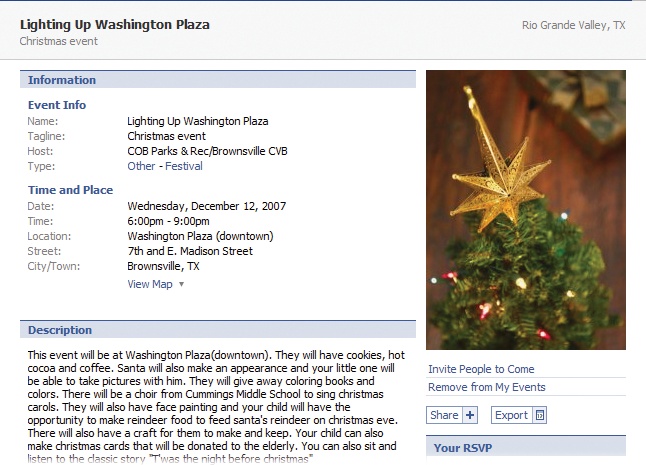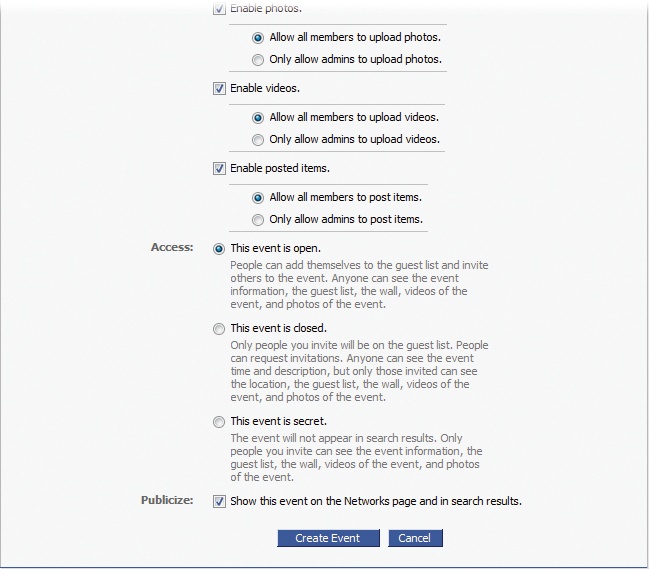Chapter 7. Facebook and the Real World: In-person Events
Connecting with online pals in the real world is becoming more and more popular. Facebook’s event listings help you find out what’s going on in your own backyard—everything from birthday parties and gallery openings to study sessions and protest marches. And because RSVPing to events lets your Facebook friends see that you’re planning to attend, a tiny get-together can quickly burgeon (“Well, hey, if Bob and Muffy are going, then I’m going!”). This chapter shows you how to find out what events are happening in your area, who’s attending, and how to set up your own events.
The Three Different Kinds of Events
Face-to-face raises privacy issues that don’t exist online. As creepy as someone might be online (leaving weird or threatening notes on your wall, poking you a hundred times a day, or joining every group you join), the worst risks you take are annoyance, embarrassment, and the possible filching of some personal data, all of which Chapter 13 helps you prevent. In person, though, that same creepiness could conceivably translate into actual bodily harm. So be extremely careful if you arrange a real-life meeting with someone (or a group of people) you met on Facebook.
To help deal with the privacy issues and safety concerns raised by in-person events, Facebook offers these event types:
Open events. Any Facebook member can read about an open event on the event’s profile page and add himself to the guest list. Open events are great for festivals, concerts, and other get-togethers held in public venues. You know an event is open by the “Add to My Events” link on the search listing description for the event (Searching for Events by Name or Subject), and by the “This is an open event” message on the Event Type section of the event’s profile.
Closed events. Any Facebook member can see a description of the event on the event’s profile page, but nobody gets on the guest list without an invitation. Anyone can request an invitation, but the event’s administrator gets the final say. Closed events are perfect for club and school meetings. You know an event is closed when you see the Request Invitation link (or the “closed” description) on the event’s profile.
Secret events. Only those people who receive an invitation (either via Facebook notification or email) can tell that the event exists. Use this kind of event when you’re planning a business meeting, private party, or intergalatic invasion.
Note
The event administrator—the person who dreams up the event, adds it to Facebook, and manages the guest list—gets to decide what kind of event it is.
Finding Existing Events
Facebook gives you four different ways to find events you might want to attend:
Search for events by name or subject. You can find events using the same search box you use to look up Facebook members (Finding Friends).
Browse for events. Browsing lets you look at all the events scheduled during a specific time period, related to a certain network, or held for a particular reason. For example, you can find all the political rallies planned for your town in the next week.
Check out the events your friends plan to attend. There’s a good chance you’ll be interested in the activities your friends enjoy.
Take a peek at the most popular events. You can see a list of the hottest events in your networks based on RSVP activity in the past 24 hours.
Searching for Events by Name or Subject
If you know the name or subject of the event you’re looking for—or at least a word or two of the name or subject—the easiest way to find it is to search for it directly.
Note
It probably goes without saying, but for you to be able to look up a karate-related event, the event’s creator had to put the word karate in the name of the event or somewhere in the description.
To do so:
In the Search box just above the Applications menu, type the name of an event or words you want to search for, and then hit Return.
Note
You can also search for events using the search box on the Events page. To get there, click Events in the Applications menu.
On the search results page that appears, click the Events tab. Doing so filters out all the non-event results.
Click the name of an event to see its profile page. Alternatively, you can click the View Event link. Either way, the page that appears describes the event in detail and lists confirmed and possible attendees (scroll down to see all the particulars).
Browsing for Events
When you browse, at first you get a list of all the events scheduled on Facebook, but you can narrow your focus to events based on a bunch of criteria. Here’s how:
From the Applications menu, choose Events. Up pops the Events page, with Upcoming Events tab displayed. If you’ve RSVPed to any events, they show up here.
Click Browse Events. The Browse Events page that appears lists all the events in the next 30 days that are associated with your networks. (When you create an event—see Creating Your Own Events—you have to link it with a network.)
Note
Facebook doesn’t automatically show you events associated with the Global network, although you can look up these events (see Seeing Your Friends’ Events). Global events are a special breed: Because they aren’t tied to any particular place, they’re no good for scheduling face-to-face meetings. People use them for things like everybody-beam-good-thoughts-together-at-midnight meetings, political announcements, and call-in Internet radio shows.
Narrow your search. You can:
See events scheduled for a particular day by clicking any shaded day on the calendar. (Unshaded days don’t have any events scheduled.)
See events associated with a network (including the Global network) by choosing it from the Network drop-down list.
See all the events during the week or month ahead by choosing one of the options from the Date drop-down list.
See only certain types of events—like parties, meetings, or school-related functions—by choosing from the Type drop-down list.
Seeing Your Friends’ Events
Checking out the events your friends are going to can be illuminating. (“Ralph’s into cross-stitch? No way!”) It might also turn up events that you’re interested in attending. Here’s how: From the Applications menu, choose Events. Then, on the Events page that appears, click the Friends’ Events tab.
RSVPing to an Event
Sure, you could show up at an event without RSVPing first, but that would be rude! It would also mean that you’d miss out on the social networking benefits Facebook offers, because as soon as you RSVP, all your friends can see where you’re headed—which may encourage them to join in the fun.
Note
Depending on how the event’s administrator set up the event, other folks in the network associated with the event will be able to see that you’re planning to attend (Creating Your Own Events).
There are two ways to RSVP to an event:
If you received an invitation, simply respond to it by following the instructions in the email or Facebook notification. You can be invited to any kind of event (open, closed, or secret), but the only way to RSVP to a secret event is by responding to an invitation, since you wouldn’t even know about the event if you hadn’t been invited.
Note
To finagle an invitation to a closed event, click the Contact Information link on the event’s profile page to send the event’s administrator a polite email request.
If you weren’t explicitly invited, head either to the event’s listing (Seeing Your Friends’ Events) or its profile page (Searching for Events by Name or Subject) and click “Add to My Events”. If the event is open, you’re in. Facebook updates the event’s profile page to show that you’re a confirmed guest, and gives you new options you can use to change your response (to “maybe” if your plans change, for example) or to invite other people. Facebook also adds the event to the Upcoming Events tab of your Events page (which you can see by heading to the Applications menu and clicking Events).
Note
Whether or not you can add yourself to an event’s guest list, invite other people, see the guest list, write on the event’s wall, or otherwise interact with an event’s profile page depends on how the event’s administrator set it up. (Creating Your Own Events.)
Creating Your Own Events
Whether you want to host a product launch party, start a study group at the local coffee shop, or have a community meeting, it’s easy to set up your own events on Facebook.
Tip
If an event is closely tied to a Facebook group you created or that you’ve been made administrator of—say you want to set up a monthly face-to-face meeting of your book club, for example—you’ll want to head to your group’s profile page (Browsing for Groups), click Create Related Event, and then follow steps 2–6 below. Doing so tells Facebook that your group is hosting the event and lets you invite all the group’s members in one fell swoop by clicking the Invite Members button that appears on the “Step 3: Guest List” tab (see step 7).
Here’s what you do:
From the Applications menu, choose Events.
On the Events page that appears, click “Create an Event”.
On the “Step 1: Event Info” tab, fill out as many of the fields as possible. Some fields—like the event’s name, the network you want to associate it with, and the time and location—are required, but you should fill in as many of the fields as you can. Doing so makes events easier for people to find, because they can search on every word you add. It also encourages people to RSVP, since the more people know about an event (and the better you make it sound, of course), the more likely they are to attend.
Tip
If you fill in the Street and City/Town fields, Facebook displays a helpful map on your event’s profile page.
Decide how open you want your event to be. Facebook assumes you want an open event that everyone on the site can view and attend, and that all attendees can contribute to by uploading photos, videos, links, and wall posts. If that’s fine with you—for example, if your event is one that’s open to the public and is listed in the local newspapers, or is an “attend in spirit only” kind of event—you don’t have to do a thing. Otherwise, you need to tweak your event’s options by turning off checkboxes and turning on radio buttons. The descriptions next to each option give you a pretty clear idea of what each one does.
Tip
For most face-to-face events, you’ll want to choose “This event is closed” so you don’t get a bunch of riffraff showing up. If you have a very specific, finite guest list and the event is private (such as a business meeting or intimate birthday gathering), choose “This event is secret”; that way, you can invite just the folks on your list and not have to worry about strangers requesting invitations.
Note
Don’t obsess about which settings to choose for your event. You can always change them later by clicking the Edit Event link on your event’s profile (Browsing for Events).
Click Create Event. Facebook posts a bare-bones version of your event on the site that people can find in searches.
On the “Step 2: Picture” tab that appears, browse for the image file you want to appear on your event listing, and then click Upload Picture. Technically, this step is optional, but a clever photo, drawing, or logo will make your event listing a lot more appealing. If you don’t want to upload a picture, click “Skip for Now”.
Invite some guests. Facebook lists your friends and Friend Lists (Viewing a Friend List) on the “Step 3: Guest List” tab that pops up, so all you need to do to invite them is choose who you want to invite and then click Add.
Note
Facebook events are supposed to be for your friends (or for the members of groups you’re in charge of—see If You’re the Group Creator). So you can’t invite Facebook members to events unless they’re your friends—but you can invite pals who aren’t yet Facebook members. To do so, on the Guest List tab, head to the “Invite People who are not on Facebook via Email” text field and type in email addresses separated by commas, and then click Add.








